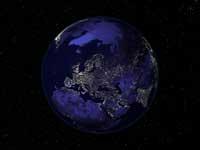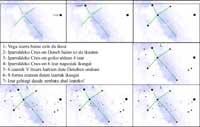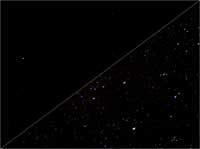Do you want to count stars?

If there are two places with different luminosity, in both the darkest one can see what is in the clearest one, and vice versa no. For example, from the window of a house in which the light is lit at night, we can look inside and see what is there. For those who are inside the house, however, it will be more difficult to see us.
The same happens when we are in nuclei of illuminated population: the light of the streets prevents us from seeing the stars in the sky. The greater the illumination, the less stars we can see, since the less luminous stars go “disappearing” from our eyes.

Campaign to learn about light pollution
With the aim of measuring light pollution around the world, the University Association of Atmospheric Analysis of the United States carried out during the first fortnight of October a campaign in which the large number of stars were analyzed worldwide. They asked for the participation of any volunteer willing to be looking at the stars, anyone could do so anywhere in the world. The work to be done was to count the stars that could be seen in the sky during the two hours following sunset and, of course, to report on the exact place of observation.
The truth is, they should not count, but determine the clarity of the more modest stars they saw. To measure luminosity, astronomers use the term magnitude. This term was invented by ancient Greeks. Around the year 150. The Greeks divided the stars they could see in the sky in six groups, according to their luminosity: the brightest stars were classified in group 1, that is, with a magnitude 1, and the lowest ones were grouped in group 6 or in magnitude.
This classification has been maintained to date. However, with their current tools, astronomers have distinguished many more ranges of luminosity. With the best telescopes we can distinguish stars of magnitude 25 and 27 that can not be seen at the naked eye, reaching to define stars of magnitude -4,4 between those of great luminosity (leaving aside the sun, of course, with magnitude -26,8).

However, without a telescope, human eyes can distinguish stars between magnitudes 1 and 6, range of magnitudes they have used in the campaign we are dealing with. But, how do we know of what magnitude are the stars we are seeing? The organization knew that this problem would be produced and facilitated the work. First, participants were given the references to be taken in the night sky for correct location (the reference points were different if they were in the northern or southern hemisphere). Then the stars of each magnitude were explained by an explanatory sheet in which the distribution in the sky of the stars of greater magnitude (of lesser luminosity) was reflected, which could be seen according to light pollution. They gave seven possible options and the spectator had to choose with which one of them fit better what he saw in the sky.
This knowledge allowed us to know the impact of light pollution in each place. According to the organizers, in optimal conditions, when there is no moon or cloud and it is very far from the light points, we can count about 14,000 stars at a glance. Since discounting the figures of those 14,000, we can know how many stars have stolen the illumination of our country.
Published in 7K.
Buletina
Bidali zure helbide elektronikoa eta jaso asteroko buletina zure sarrera-ontzian











